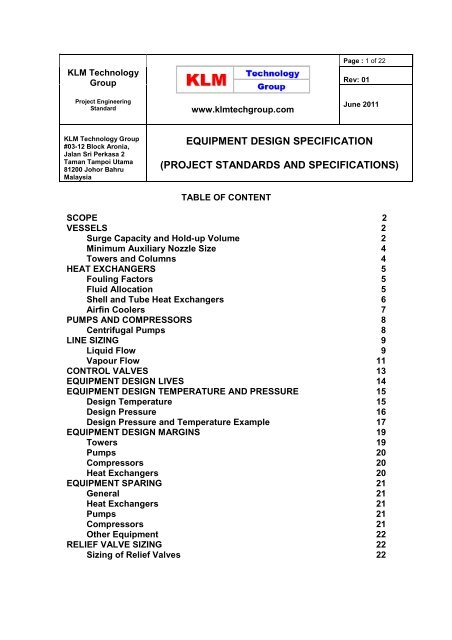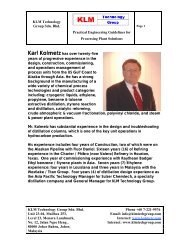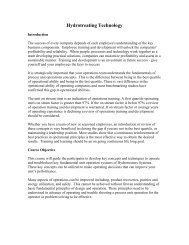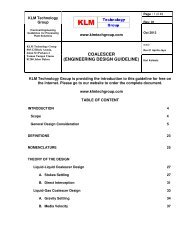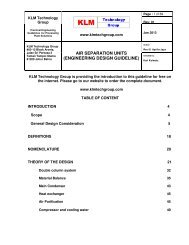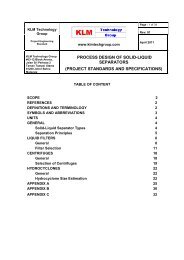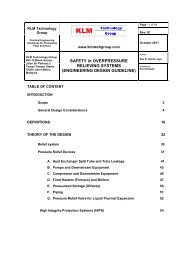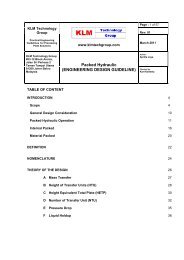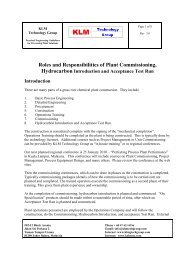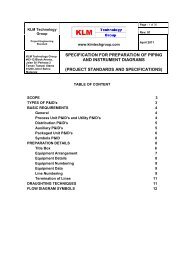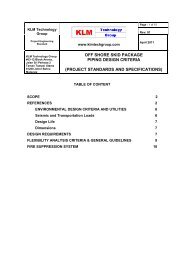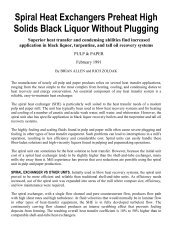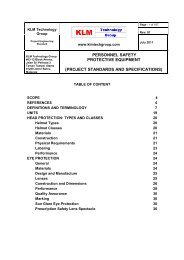equipment design specification - KLM Technology Group
equipment design specification - KLM Technology Group
equipment design specification - KLM Technology Group
Create successful ePaper yourself
Turn your PDF publications into a flip-book with our unique Google optimized e-Paper software.
<strong>KLM</strong> <strong>Technology</strong><strong>Group</strong>Page : 1 of 22Rev: 01Project EngineeringStandardwww.klmtechgroup.comJune 2011<strong>KLM</strong> <strong>Technology</strong> <strong>Group</strong>#03-12 Block Aronia,Jalan Sri Perkasa 2Taman Tampoi Utama81200 Johor BahruMalaysiaEQUIPMENT DESIGN SPECIFICATION(PROJECT STANDARDS AND SPECIFICATIONS)TABLE OF CONTENTSCOPE 2VESSELS 2Surge Capacity and Hold-up Volume 2Minimum Auxiliary Nozzle Size 4Towers and Columns 4HEAT EXCHANGERS 5Fouling Factors 5Fluid Allocation 5Shell and Tube Heat Exchangers 6Airfin Coolers 7PUMPS AND COMPRESSORS 8Centrifugal Pumps 8LINE SIZING 9Liquid Flow 9Vapour Flow 11CONTROL VALVES 13EQUIPMENT DESIGN LIVES 14EQUIPMENT DESIGN TEMPERATURE AND PRESSURE 15Design Temperature 15Design Pressure 16Design Pressure and Temperature Example 17EQUIPMENT DESIGN MARGINS 19Towers 19Pumps 20Compressors 20Heat Exchangers 20EQUIPMENT SPARING 21General 21Heat Exchangers 21Pumps 21Compressors 21Other Equipment 22RELIEF VALVE SIZING 22Sizing of Relief Valves 22
<strong>KLM</strong> <strong>Technology</strong><strong>Group</strong>Project Engineering StandardEQUIPMENT DESIGNSPECIFICATION(PROJECT STANDARDS ANDSPECIFICATIONS)Page 2 of 22Rev: 01June 2011SCOPEThe purpose of this Project Standard and Specification is to ensure consistencyof approach to <strong>design</strong> of <strong>equipment</strong> across the whole project. The Contractorshall incorporate the <strong>design</strong> requirements related to the compressor station intothe <strong>design</strong>.VESSELSSurge Capacity and Hold-up Volume1. Drum Surge Capacity and Hold-up VolumeFor drums the surge capacity is arbitrarily defined as the volume betweenhigh and low liquid levels.If a uniform discharge rate is important, provide the general hold-up timesrecommended below:ServiceHold-up Time, MinutesFeed to Tower or Furnace (feed surge)Drum diameter, metres- below 1.22 20- from 1.22 to 1.83, inclusive 15- above 1.83 10Reflux to Tower 5Reflux to De-ethaniser 20Reflux to De-propaniser 10Product to Storage 2Flow to Heat Exchanger 2Flow to Sewer or Drain 1In case hold-up must be provided for both product and reflux, the largervolume is used, not the sum of the two volumes.When the discharge rate is unimportant, a nominal hold-up time ofapproximately two (2) minutes is provided.The normal operating level should be taken as the midpoint between the highand low levels. Level control should span between the high and low levels.Where high and low level trips are required, these should be located at areasonable elevation above and below the high and low levels respectively, toallow operator intervention before a trip occurs.Low Liquid LevelLow liquid level shall be at least 200 mm above the bottom (for horizontalvessels) or bottom tangent line (for vertical vessels).
<strong>KLM</strong> <strong>Technology</strong><strong>Group</strong>Project Engineering StandardEQUIPMENT DESIGNSPECIFICATION(PROJECT STANDARDS ANDSPECIFICATIONS)Page 3 of 22Rev: 01June 2011For water settling, this may need to be increased. Where there may be solidsin the drum, which are not to be drawn off, the liquid outlet may be raised andthe low liquid level shall be increased accordingly.High Liquid Level and Vapour DisengagementFor horizontal vessels the HLL is either 300mm or 20% of the drum diameterfrom the top, whichever is the greater. Note: if a crinkled wire mesh pad ispresent then HLL is 300 mm from the bottom of the pad.For vertical vessels, if vapour is present the HLL is 300mm to the bottom ofthe inlet arrangement. If no vapour is present it is either 15% of the drumdiameter or 300mm whichever is the greater.2. Tower Bottoms Surge Capacity and Hold-up VolumeThe liquid residence time (from the low to high levels) for the <strong>design</strong> of thebottom section of a column is as follows:a. Bottoms as feed to a subsequent tower on level control is five (5) minutes.In general, level control will frequently prove satisfactory to the second of aseries of towers.b. Bottoms as feed to a subsequent tower on flow control is ten (10) totwenty (20) minutes, when the column is acting as a feed surge drum toanother unit. This surge capacity may be obtained by swaging out the holdup section of the column, in some cases.c. Bottoms to a heat exchanger and/or tankage are two (2) minutes.d. Feed to a fired coil reboiler is the sum of five (5) minutes on the vaporisedportion and two (2) minutes on the bottoms product. It is normallydesirable that the five (5) minutes on the vaporised portion be employed toestablish the normal low level, with the subsequent two (2) minutes onbottoms product used to establish the high liquid level (normally 300mm isthe minimum allowed distance between these (levels).3. Knockout Drum Surge Capacity and Hold-up VolumeFor normal accumulation the following liquid hold up applies:a. At low normal accumulation rateLiquid drawoff is usually manually controlled . Enough volume should beprovided to ensure the frequency of emptying is less than once per shift(i.e. eight (8) hours) or preferably twenty four (24) hours. Generally anominal height above the lower tangent line (say 200mm) will beadequate.
<strong>KLM</strong> <strong>Technology</strong><strong>Group</strong>Project Engineering StandardEQUIPMENT DESIGNSPECIFICATION(PROJECT STANDARDS ANDSPECIFICATIONS)Page 4 of 22Rev: 01June 2011b. At higher normal accumulation rateLiquid drawoff is usually under level control. The distance between highand low level is usually made to suit a standard controller range, say 350mm, (corresponding to controller connections and generally providing holdup time far in excess of the normal requirement of approximately two (2)minutes).Minimum Auxiliary Nozzle SizeThe following list is a guide to the minimum auxiliary nozzle sizes to be used forprocess <strong>design</strong> sizing of nozzles (minimum mechanical nozzle size of 2” to bespecified during vessel <strong>design</strong>).Vessel Volume (m 3 ) Vent Drain Pumpout Steamout Blowdown1.5 2” 2” 2” 2” 2”1.5 – 5.6 2” 2”” 2” 2” 3”5.6 – 17 2” 2” 2” 2” 3”17 – 70 2” 3” 3” 2” 4”70 and over 2” 3” 3” 3” 4”Towers and Columns1. Minimum Tray SpacingAll distances are mm:Tower ID Max Tray Passes Min Tray Spacing Valveor Sieve750 to 1800 1 5001800 to 2700 2 5002700 to 3300 2 6003300 to 4800 4 6004800 to 6000 4 600> 6000 4 750For draw off trays, the spacing is set by the draw off tray <strong>design</strong>, includinghold up.2. L/DTowers with L/D greater than 25 shall be avoided if possible due to supportproblems.
<strong>KLM</strong> <strong>Technology</strong><strong>Group</strong>Project Engineering StandardEQUIPMENT DESIGNSPECIFICATION(PROJECT STANDARDS ANDSPECIFICATIONS)Page 5 of 22Rev: 01June 20113. Allowable Pressure Drop GuidelinesTray TypeIn Pressure Servicebar per traySieve 0.007Valve 0.007HEAT EXCHANGERSFouling FactorsSite specific fouling factors will be set as shown below. However, where Licensorhas requirements, which are more stringent than this, then Licensor values shallbe applied.- Steam 0.1 m 2º C/kW- Light Hydrocarbon 0.2 m 2º C/kW- NGL/Hot Oil/ Tempered Water 0.35 m 2º C/kW- For Licensed Units, Licensor to specify fouling factors in Front EndEngineering Design (FEED) PackageIn the absence of specific guidelines TEMA Standards 8 th Edition 1999 should bereferred to.Fluid AllocationTo allocate fluids to shell or tube side of an exchanger, the following generalprinciples of fluid allocation shall apply:a. cooling water on tubeside;b. high pressure fluid on tubeside;c. most corrosive fluid on tubeside;d. higher fouling fluid on tubeside;e. less viscous fluid on tubeside;f. large volume of condensing vapours on shellside;g. single phase fluids both sides put smaller flow on shellside.The above principles may conflict in some instances and alternative <strong>design</strong>s shallbe investigated. In these cases the most economical <strong>design</strong> shall be selected.
<strong>KLM</strong> <strong>Technology</strong><strong>Group</strong>Project Engineering StandardEQUIPMENT DESIGNSPECIFICATION(PROJECT STANDARDS ANDSPECIFICATIONS)Page 6 of 22Rev: 01June 2011Shell and Tube Heat Exchangers1. Pressure DropsThe pressure drop available shall be specified as below and all hydrauliccalculations shall allow for this specified pressure drop.2. LiquidsTotal Pressure Drop (bar) for Liquid Flow Through Shells in SeriesViscositycP @ avg.temperature o COne ShellPressure Drop(bar)Two ShellsPressure Drop(bar)Three ShellsPressure Drop(bar)< 1.0 0.34 – 0.69 0.34 – 0.69 0.69 – 1.031.0 to 5.0 0.69 1.03 1.03 – 1.385.0 to 10.0 1.03 1.03 – 1.38 1.38> 10.0 1.38 1.38 – 2.07 2.07GasesPressure Drop (kg/cm 2 ) for Vapour FlowOperating Pressure (barg)Pressure Drop (bar)0 – 0.69 Approx. 0.03 - 0.07> 0.69 0.14 – 0.343. Condensers and Reboilers- For partial condensers allow 0.14 to 0.34 bar.- For condensers where total isothermal condensation takes place, thepressure drop is usually low or negligible.- For surface condensers allow 3 - 5 mm Hg for operating pressures about30 mm Hg.- For kettle type reboilers the shell side pressure drop is generally termed‘negligible’.- For thermosyphon type reboilers (horizontal units, once-thru andrecirculating) the exchanger pressure drop must be low and is normally inthe region of 0.017 to 0.034 bar, due to “unbaffled” exchangerconstruction.Maximum Removable Bundle Weight, Diameter and Tube Length- Maximum removable bundle weight allowable on site is 20 tonnes.- Maximum removable bundle diameter allowable on site is 2.0 m.- For removable bundles a tube length of 6100 mm shall be maximum.


